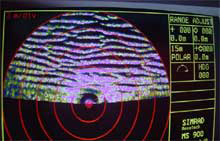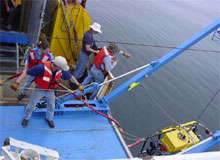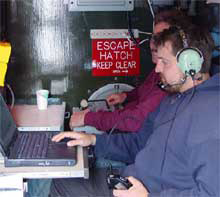Cordell Bank National Marine Sanctuary
Operation of the ROV in Cordell Bank
June 5, 2002
Michael Carver, Biological Technician
Cordell Bank National Marine Sanctuary
![]() Watch video footage taken from the remotely operated vehicle. (mp4, 1.35 MB).
Watch video footage taken from the remotely operated vehicle. (mp4, 1.35 MB).
At the edge of the continental shelf about 50 miles north of the Golden Gate, Cordell Bank rises from the seafloor. The submerged island is replete with pinnacles of granitic rock that rise to within 120 ft of the ocean's surface, and are teeming with life. The pinnacle habitat of the Bank is encrusted with colorful hydrocorals, sponges, and countless invertebrates all competing for space. Surrounding the large boulders are clouds of various rockfish species. Strong upwelling in this region, combined with topography and the southbound California current, result in a very productive marine ecosystem. It is for this reason we are here to explore regions of the Bank that humans have never seen before.
Scientists use many tools to explore the oceanic environment—from sensors and nets, to ROVs and submarines. Just as astronauts use unoccupied vehicles to explore the outer regions of space, so do the scientists of Cordell Bank National Marine Sanctuary to explore the depths below the surface.
The components of the system include the ROV and a small “boxlike” van, which houses all the displays and controls. For Sanctuary Quest 2002, mission control is stationed on the back deck of the NOAA ship McArthur. The van houses a dozen displays, which all show different data regarding the ROV. The ROV is equipped with three cameras, SONAR, and positioning laser beams. On the SONAR screen in the van, the operators can see what lies ahead. In the image above, sand furrows on the southern end of the Bank are clearly visible on the SONAR. The sand furrows' depth and direction are sculpted from the strong currents that prevail at Cordell Bank.
During the Cordell Bank leg of Sanctuary Quest, we dove at six different stations on the Bank using the ROV. On the first day, we covered the southern end of the Bank and the sand-furrowed habitat. On the second and third days, we covered pinnacle habitats in the northern region of the Bank. The dives have been a great success. Countless hours of video footage and 1,000 digital still images were taken as we saw parts of the Bank for the very first time. The success of the dives largely has been the result of the synchronicity among the good working order of the ship, the ROV operations team, and the weather. From the first day, the ROV operations team hit a rhythm.
The Team
The ROV team consists of Vince, Michael, Todd and Ian. The responsibilities are shared, although each individual has his area of expertise. Vince oversees navigation while coaching Todd on how to run the deck. Ian is the pilot for the mission and maintains a steady course. Michael coordinates the needs of the scientist and the captain of the McArthur, maintaining a balance so that the ship speed does not go above 0.5 knots.
Todd oversees the launch and recovery of the ROV as well as troubleshoots during the cruise. Todd also tends the tether, and conducts preflight inspections of the ROV to ensure the smooth operation of the dive. Vince has been working with ROVs for nearly twenty years. Michael sits with one hand on a shutter release for the camera, and the other on an intercom that links the ship's communications and chief scientist Dan Howard. He snaps the shutter anticipating what is coming into the frame. At the same time, he monitors the SONAR, conferences with Dan and the bridge on a headset, and determines where Ian should direct the ROV. Ian expertly navigates the ROV through very difficult terrain, keeping a sharp eye on the constantly changing screen. On this cruise, he has more than once tracked exciting species, such as a six gill shark, while operating lasers, lights, and numerous controls.
Life in the ROV trailer is anything but mellow when we approach high relief areas. The pilot is in constant need of position updates, the deck is busy lifting the depressor (a thousand pound weight that keeps the ROV down at the bottom), and the conductor is trying to keep everyone synchronized, so that the scientists can collect data. When we finally surface at the end of a 3-to 4-hour dive, we are greeted by large flocks of Black-footed Albatross.
The use of technology to gain information about inaccessible habitats is invaluable. The science team is just beginning to explore the many habitats at Cordell Bank. The Sanctuary staff hopes to continue to learn about the fragile, yet incredibly productive Cordell Bank ecosystem using ROV technology.




























